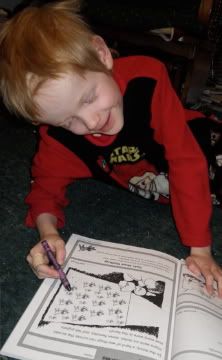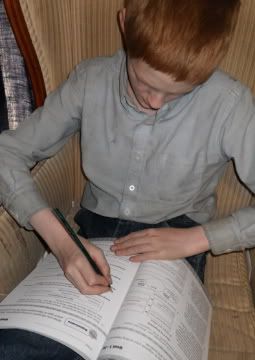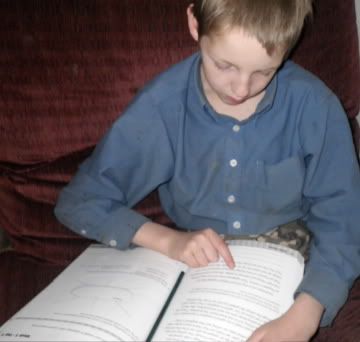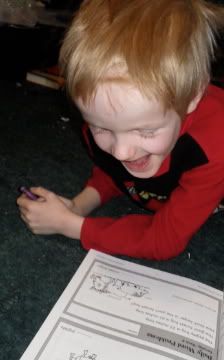Of course, they arrived when we had a huge round of something going through the house, so we got off to a rough start.
The one we've worked with the most is the Daily Word Problems. Richard was not too impressed when we started, but we worked through the first couple weeks of problems at a pace well higher than the one a day that is recommended. That meant we got to problems that he actually enjoyed for the latter half of this review.
The idea is that the child works one word problem a day, which takes a few minutes at the very most, and you are gradually building up some pretty amazing word problem skills. Each week in the 1st grade book focuses on a type of animal, and after all five problems are done for the week, there is a little section with facts about that animal. Those have been a really nice reward.
The problem he is working on in the picture to the left is from week 9, which is about warthogs. It reads:
The pygmy hog is 23 inches long. The giant forest hog is 63 inches long. How much longer is the giant forest hog?
There is a space for the child to write out a number sentence (I LOVE THIS!) and there is an already labeled blank for the answer: _____ inches longer
 This format is fabulous. Richard is able to easily do all the math so far, but he is way too much like his oldest brother. He intuitively knows the answer, but he struggles to tell you how he got there. With this problem, he immediately answered "40 inches longer" and now that we've been forcing these number sentences for a few weeks, he was able to eventually tell me that "63 minus 23 equals 40" -- but when we started the book, he could not do that.
This format is fabulous. Richard is able to easily do all the math so far, but he is way too much like his oldest brother. He intuitively knows the answer, but he struggles to tell you how he got there. With this problem, he immediately answered "40 inches longer" and now that we've been forcing these number sentences for a few weeks, he was able to eventually tell me that "63 minus 23 equals 40" -- but when we started the book, he could not do that.This is, for the record, one of the harder math problems he has had to solve so far, but he has not struggled with the math part. I love that aspect. Make the math relatively easy, but start working him through the idea of picking out the pertinent details and creating his own math problem. Well, eventually, maybe. Right now, he picks out the pertinent details, gives me the answer, and then figures out what the problem was.
The other photo, with him also in his pajamas, is the last warthog problem, and it involves adding three numbers (males, females, piglets).
I am going to continue to use the Daily Word Problems books, including finding some for my older kids. Timberdoodle sells these books for Grades 1 through 6, along with a whole bunch of other cool math items.
Daily 6-Trait Writing did not go quite so well here. I'm trying to figure out what I want to do to make this work out better for us.
 Both the Grade 4 and Grade 5 books are set up in a similar manner. For each week, you start with a two-page spread for the teacher that shows mini versions of all the student workbooks and that gives details about teaching for that day. They are very easy to implement, which I really like. After that, there are four worksheet pages (Monday-Thursday), with the fifth day's assignment being a writing prompt. There are 25 weeks of lessons.
Both the Grade 4 and Grade 5 books are set up in a similar manner. For each week, you start with a two-page spread for the teacher that shows mini versions of all the student workbooks and that gives details about teaching for that day. They are very easy to implement, which I really like. After that, there are four worksheet pages (Monday-Thursday), with the fifth day's assignment being a writing prompt. There are 25 weeks of lessons.Week 3 of the Grade 4 text, for instance, is on developing characters, setting and plot ideas. Day 1 focuses on characters, Day 2 on setting, Day 3 on plot. Then Day 4 has you create a basic idea for a story (pulling all of the above together), and Day 5 has you actually writing the story.
Thomas loved the activities that got him thinking about details describing these story elements. He broke down a bit when it came to pulling it all together to create his own story.
 William was similar. For most weeks, he enjoyed the first three days of the assignments, where he was filling in blanks or otherwise pulling together the basics. It was the sum it all up activities assigned to Day 4, and the writing prompts from Day 5 that were challenging for me to do with him.
William was similar. For most weeks, he enjoyed the first three days of the assignments, where he was filling in blanks or otherwise pulling together the basics. It was the sum it all up activities assigned to Day 4, and the writing prompts from Day 5 that were challenging for me to do with him.What we are doing is to ditch the Grade 5 book, and I have both boys working from Grade 4 (Grade 5 is just enough too much for my 4th grader!) and that is going better. They are able to brainstorm together, which makes a huge difference. The great thing is that the buyer is permitted to photocopy pages in this book for single-classroom use, so I can do this!
I love that this covers a lot of really great writing concepts, and it does it in a sequential manner. Each week focuses on an idea, plus there is a "convention" of the week too... such as various punctuation rules, homonym use, or double negatives.
The Daily 6-Trait Writing is available for Grades 1-6, along with a lot of other fun language arts products.
Disclosure: As a member of Timberdoodle's Blogger Review Team I received a free copy of these books in exchange for a frank and unbiased review.

No comments:
Post a Comment